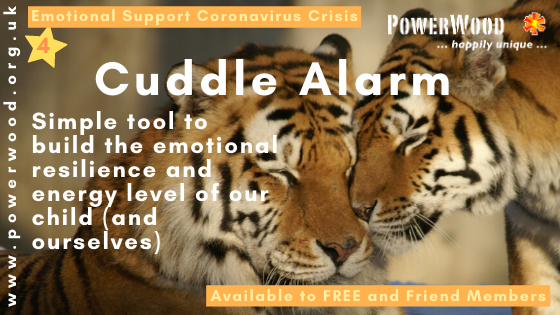To facilitate access to all PowerWood articles in the PowerWoods Emotional Coronavirus Crisis Guide are also available to non-members. If you enjoy reading the articles please support PowerWood by becoming a PowerWood Community FreeBee or Friend member. Thank YOU!
Please visit for medical health guidelines and regulations your government website and your local healthcare provider website. Thank you.
The Cuddle Alarm (Tool)
Tool within the Multilevel Emotion Regulation Theory (MERT)
In challenging situations or when tension has built up, we can use this simple tool. It will help to create feelings of calm and belonging and build emotional resilience, help us bond with our children and teens, and prevent unnecessary escalation by strengthening the Baseline.
Help to calm down
Giving a child a non-disturbing attention moment regularly will help them to prevent any further tension from building up, and will soothe existing tension. Oxytocin, the bonding hormone, released while touching will help our child to calm down.
You can adapt the frequency of the alarm to the stressors in your life and the child. The more stressors, the more often the Cuddle Alarm. For example, if your child is starting something new and might be nervous about it or if you have many social obligations that you find challenging and you can’t cancel them you raise the frequency.
Calm yourself before
The first step is to set your alarm to go off at an interval that works for you.
When the alarm goes off, start by first upping your own baseline by doing the 4-7-8 breathing technique, after that you can focus on your child as you know you won’t bring any unnecessary tension to the equation, as that would trigger the child in a stress response.
Give without Expectations
Secondly, you approach your child. E.g. you walk up to her/him, hug her/him for a short moment in a way that you know will cause the least irritation (firm, light etc) and say smiling (this will help you feel positive and help teens to experience you as neutral) something lightly and casual that involves gratitude, appreciation (this will also help you feel positive) as specific as you can:
“You smell so nice, I’m so glad you’re in my life”
or
“Every time I see you I have to smile” etc. Keep it sweet and short.
Don’t expect anything back and remove yourself after you have spoken and touched directly from the situation. Don’t let yourself be distracted by the grumpy reactions of teenagers, keep your eye on the ball, yes get the oxytocin flowing. This way you’re building your emotional credit with your child and the child’s emotional resilience and strengthening the bond between the two of you.
Strengthen your own Baseline
When you support your child, teen (or partner) in this way, acknowledge your effort by writing in your PowerBook, a notebook used specifically to compliment yourself on your Awareness Mantras of the day and in which to collect ways that you can use for strengthening your Baseline, such as activities you find soothing. The PowerBook is the most simple way to build your Baseline independently of others, For example, an entry might be:
“I’m proud and grateful too be aware that I had a helpful action”.
Trust the Process
If you didn’t manage to give the support you would have liked to, please don’t worry and right down in you PowerBook:
“I’m proud and grateful too be aware that I had a not helpful action”
Followed by the 4-7-8 breathing exercises to prevent any not helpful thoughts about yourself that will drain your energy further.
To be able to change behaviour we have to be aware of it, and the Awareness Mantra is a good tool to help achieve that.
By doing this you are strengthening your own emotional resilience and energy level (Baseline) whether you manage or not to live up to your own expectations.
Trust the process, if you are able to embrace the awareness and you let yourself not be distracted by not helpful thoughts, feelings, or actions, or you catch them again with the Awareness Mantra, change will follow.
Take the time to adjust, reconnect and rebalance in this new situation
PowerWood’s Community
Find understanding, tools and strategies that work in an understanding, respectful and compassionate Community.
PowerWood can be your and your families advocate and your second family.
Explore how joining our PowerWood community by becoming a member will benefit you and your family and what types of memberships are available.
Join our Community
Available to Members*
*Booking a one-off Free Introductory Talk of 45-60 minutes by Skype or FaceTime with Senior Consultant Simone de Hoogh is one of the benefits of being either a FreeBee PowerWood Community Member or a Friend PowerWood Community Member.
Book a FREE Introductory Talk with a Professional*
You can read more about PowerWood’s Consultancy Sessions, the Benefits of a Free Introductory Talk and PowerWood’s Consultancy Services Tiered Fee Structure.
*Overexcitability Test
OE (Overexcitability) is an element of a Developmental Theory –Theory of Positive Disintegration by Dabrowski- that is one of the underpinning theories of MERT (Multi-level Emotion Regulation Theory) developed by Simone de Hoogh. Overexcitability explains and allows us to look at ‘extreme’ behaviour as a valuable asset in our or our children’s life.
Find out if you or your child has OE (OverExcitability) as well
*Boundary Test
A HUGE thank YOU to the son and daughter of Ernest Hartmann’s who gave PowerWood permission to use and put the full academically approved questionnaire about the Boundary in the Mind on PowerWood’s website.
Find out how the Boundary in the Mind affects you or your child

